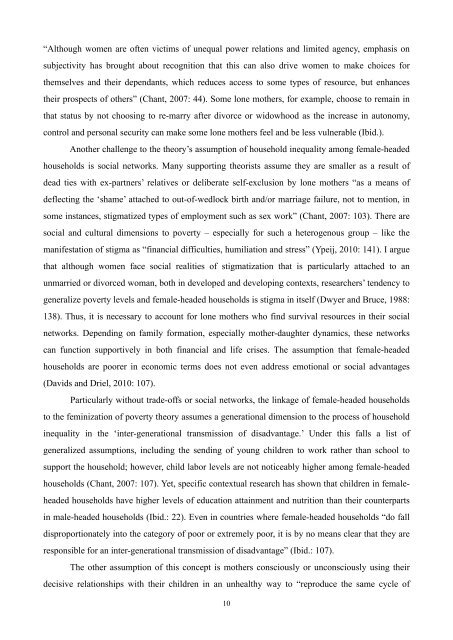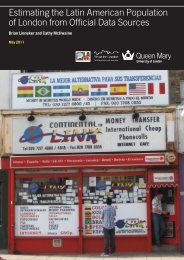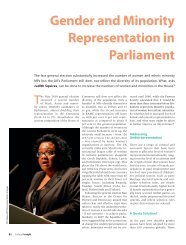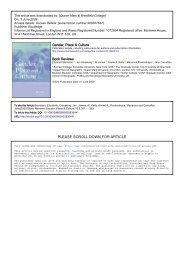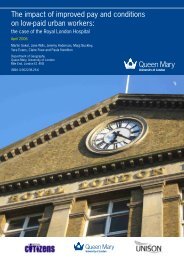Women's Empowerment and the Feminization of Poverty among
Women's Empowerment and the Feminization of Poverty among
Women's Empowerment and the Feminization of Poverty among
- No tags were found...
Create successful ePaper yourself
Turn your PDF publications into a flip-book with our unique Google optimized e-Paper software.
“Although women are <strong>of</strong>ten victims <strong>of</strong> unequal power relations <strong>and</strong> limited agency, emphasis onsubjectivity has brought about recognition that this can also drive women to make choices for<strong>the</strong>mselves <strong>and</strong> <strong>the</strong>ir dependants, which reduces access to some types <strong>of</strong> resource, but enhances<strong>the</strong>ir prospects <strong>of</strong> o<strong>the</strong>rs” (Chant, 2007: 44). Some lone mo<strong>the</strong>rs, for example, choose to remain inthat status by not choosing to re-marry after divorce or widowhood as <strong>the</strong> increase in autonomy,control <strong>and</strong> personal security can make some lone mo<strong>the</strong>rs feel <strong>and</strong> be less vulnerable (Ibid.).Ano<strong>the</strong>r challenge to <strong>the</strong> <strong>the</strong>ory’s assumption <strong>of</strong> household inequality <strong>among</strong> female-headedhouseholds is social networks. Many supporting <strong>the</strong>orists assume <strong>the</strong>y are smaller as a result <strong>of</strong>dead ties with ex-partners’ relatives or deliberate self-exclusion by lone mo<strong>the</strong>rs “as a means <strong>of</strong>deflecting <strong>the</strong> ‘shame’ attached to out-<strong>of</strong>-wedlock birth <strong>and</strong>/or marriage failure, not to mention, insome instances, stigmatized types <strong>of</strong> employment such as sex work” (Chant, 2007: 103). There aresocial <strong>and</strong> cultural dimensions to poverty – especially for such a heterogenous group – like <strong>the</strong>manifestation <strong>of</strong> stigma as “financial difficulties, humiliation <strong>and</strong> stress” (Ypeij, 2010: 141). I arguethat although women face social realities <strong>of</strong> stigmatization that is particularly attached to anunmarried or divorced woman, both in developed <strong>and</strong> developing contexts, researchers’ tendency togeneralize poverty levels <strong>and</strong> female-headed households is stigma in itself (Dwyer <strong>and</strong> Bruce, 1988:138). Thus, it is necessary to account for lone mo<strong>the</strong>rs who find survival resources in <strong>the</strong>ir socialnetworks. Depending on family formation, especially mo<strong>the</strong>r-daughter dynamics, <strong>the</strong>se networkscan function supportively in both financial <strong>and</strong> life crises. The assumption that female-headedhouseholds are poorer in economic terms does not even address emotional or social advantages(Davids <strong>and</strong> Driel, 2010: 107).Particularly without trade-<strong>of</strong>fs or social networks, <strong>the</strong> linkage <strong>of</strong> female-headed householdsto <strong>the</strong> feminization <strong>of</strong> poverty <strong>the</strong>ory assumes a generational dimension to <strong>the</strong> process <strong>of</strong> householdinequality in <strong>the</strong> ‘inter-generational transmission <strong>of</strong> disadvantage.’ Under this falls a list <strong>of</strong>generalized assumptions, including <strong>the</strong> sending <strong>of</strong> young children to work ra<strong>the</strong>r than school tosupport <strong>the</strong> household; however, child labor levels are not noticeably higher <strong>among</strong> female-headedhouseholds (Chant, 2007: 107). Yet, specific contextual research has shown that children in femaleheadedhouseholds have higher levels <strong>of</strong> education attainment <strong>and</strong> nutrition than <strong>the</strong>ir counterpartsin male-headed households (Ibid.: 22). Even in countries where female-headed households “do falldisproportionately into <strong>the</strong> category <strong>of</strong> poor or extremely poor, it is by no means clear that <strong>the</strong>y areresponsible for an inter-generational transmission <strong>of</strong> disadvantage” (Ibid.: 107).The o<strong>the</strong>r assumption <strong>of</strong> this concept is mo<strong>the</strong>rs consciously or unconsciously using <strong>the</strong>irdecisive relationships with <strong>the</strong>ir children in an unhealthy way to “reproduce <strong>the</strong> same cycle <strong>of</strong>10


